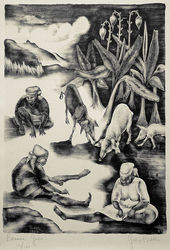
19th, 20th & 21st Century Fine Prints
707-546-7352 · fax 707-546-7924 · web: www.annexgalleries.com · email: artannex@aol.com
George Biddle Biography
George Biddle
American
1885–1973
Biography

Born on January 24, 1885 in Philadelphia, George Biddle received his B.A. from Harvard where he then completed his doctorate in law. He received art instruction at the Pennsylvania Academy of the Fine Arts, at the Académie Julian in Paris and then in Munich. During the first world war, Biddle lived in Giverny (1915-16) where he painted outdoor nudes such as Back of a Nude with Parasol (Eleanor and Irv Welling) and Summer 1919 in an impressionist manner. During this last wave of American expatriate painters at Giverny, Biddle was clearly influenced by Frederick Frieseke.
Captain George Biddle served in the G2 Section of the First Army Corps during the war, was discharged in April 1919, and traveled clear to Tahiti to erase the memories of war and to find peace (1920-22). There he explored various media: wood and stone sculpture, wood block prints and even marquetry. The Pennsylvania Academy has his painting Tahitians from that trip, which reflects Gauguin’s influence in the outlining of forms — here almost a cloisonnisme, while the human figures have a statuesque massiveness. There is no trace of the accidental lighting in the Frieseke-inspired taches of sunlight of the earlier period.
Biddle returned to America, this time to New York City and continued with sculpture, but soon he was back in Paris. That was during an exciting decade of American expatriatism — when even some bohemians were well off financially and there was plenty of intellectual and aesthetic stimulation, as Brancusi, Zadkine, Marie Laurencin, Léger, and Chagall met in the café crowd. Biddle visited Gertrude Stein’s salon, met James Joyce, Marsden Hartley, and other stars of modernism.
During the Great Depression, Biddle actively sought government funding for the arts. His correspondence with friend President Franklin D. Roosevelt (a former classmate at Groton Preparatory School and at Harvard) resulted in the establishment of the Federal Arts Project of the Works Progress Administration (WPA). The Depression fueled Biddle’s desire to create socially conscious art. He established himself as a Social Realist through powerful murals depicting poverty.
Biddle’s A Woman with a Letter (1933), which recalls both Raphael Soyer and Charles Demuth, is in the Metropolitan Museum of Art. His own murals include Society Freed through Justice in the Justice Department (1936; now in the University of Maryland), American Revolutionary scenes in the New Brunswick, New Jersey Post Office (1939), two large panels in the Biblioteca Nacional, Rio de Janeiro (1942) and two murals for the Supreme Court Building in Mexico City (1944). The Whitney Museum of American Art has Biddle’s Winter in Tortilla Flat (1941).
He died at Croton-on-Hudson, New York in 1973.
